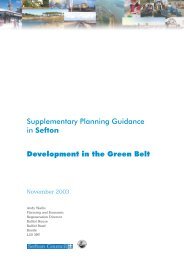The impact of sand extraction at Formby Point ... - Sefton Council
The impact of sand extraction at Formby Point ... - Sefton Council
The impact of sand extraction at Formby Point ... - Sefton Council
Create successful ePaper yourself
Turn your PDF publications into a flip-book with our unique Google optimized e-Paper software.
6<br />
only six post-1987 10km squares (hectads) in the British Isles. Nearby, are two bushes <strong>of</strong><br />
Salix x friesiana (14 post-1987 hectads), also n<strong>at</strong>ionally rare.<br />
To the west <strong>of</strong> the m<strong>at</strong>ure woodland, a zone <strong>of</strong> regener<strong>at</strong>ing scrub, mainly Balm-<strong>of</strong>-<br />
Gilead much affected by fungal die-back, gradually gives way to a gently undul<strong>at</strong>ing<br />
landscape, the veget<strong>at</strong>ion <strong>of</strong> which consists <strong>of</strong> a mosaic <strong>of</strong> grassy fixed-dune and fixed<br />
dune with Creeping Willow with sc<strong>at</strong>tered small trees <strong>of</strong> birch and pine. <strong>The</strong>re is one<br />
fine young specimen <strong>of</strong> Salix x doniana <strong>at</strong> SD 27646 06693. <strong>The</strong> western edge <strong>of</strong> the<br />
quarry here is a 3-4m-high fixed dune ridge, beyond which lies the Lifebo<strong>at</strong> Road carpark<br />
on wh<strong>at</strong> were probably originally Asparagus fields.<br />
To the south, a square pine plant<strong>at</strong>ion on top <strong>of</strong> a 3-4m-high pl<strong>at</strong>eau survived <strong>sand</strong>winning.<br />
On its southern flank, next to Lifebo<strong>at</strong> Road, is a level area which was probably<br />
one <strong>of</strong> the first to be excav<strong>at</strong>ed for <strong>sand</strong>. This is now heavily Rabbit-grazed fixed-dune<br />
domin<strong>at</strong>ed by Red Fescue (Festuca rubra) and Common Bent (Agrostis capillaris) with a<br />
diversity <strong>of</strong> herbaceous plants, including Common Stork’s-bill (Erodium cicutarium), the<br />
n<strong>at</strong>ionally scarce Sticky Stork’s-bill (E. lebelii) and their rare hybrid Erodium x<br />
anarist<strong>at</strong>um, known only from coastal dunes in Wales and South Lancashire.<br />
Immedi<strong>at</strong>ely west <strong>of</strong> the pine block is a dune hollow, a blow-out in 1978, which was<br />
deepened to produce a N<strong>at</strong>terjack Toad scrape about 20m in diameter in the 1980s (no.<br />
10). This now contains a few slack plants, the only notable species being Small-fruited<br />
Yellow-sedge. It has not been used by N<strong>at</strong>terjacks for some time but, in wet years, has<br />
been known to support dragonflies.<br />
Moving north <strong>of</strong> the wooded part <strong>of</strong> the quarry is a low-lying, almost level area traversed<br />
by footp<strong>at</strong>hs. Its veget<strong>at</strong>ion consists <strong>of</strong> a mosaic <strong>of</strong> Grey Poplar scrub (some recently cut<br />
but re-sprouting), p<strong>at</strong>ches <strong>of</strong> Creeping Willow and acid fixed-dune grassland, domin<strong>at</strong>ed<br />
by Common Bent and Sand Sedge (Carex arenaria). <strong>The</strong> l<strong>at</strong>ter also supports the notable<br />
species Smooth C<strong>at</strong>’s-ear (Hypochaeris glabra) (Smith 2007a) and Sticky Stork’s-bill.<br />
Where pedestrian trampling has kept the turf short, there is heavy Rabbit grazing. This<br />
area slopes upwards to the north by about 1.5m to a near-level pl<strong>at</strong>eau <strong>of</strong> open, partially-















